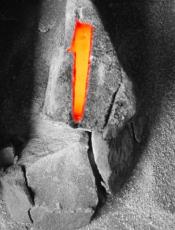
 |
Summary The making of a glass architecture from the earth of a site is about making a place on and of the land. In undergoing a transformation to the glassy state the materials of a landscape take on miraculous qualities of transparency, reflectivity, workability and structure. When this transformation takes place in situ, a strong , direct relationship between built environment and the parent landscape is created. The luminous, liquid mass of a cast glass foundation, together with gravity, finds its own level within the topography of a landscape. Delicate glass structures, which catch, transmit and reflect light, can be drawn from up from the ground line of a molten earth foundation. Through chemistry and morphology the shared history of building and landscape is recorded. To transmute the earthy materials of a site to glass requires infinite variation of approach and recipe for each unique site. However , a set of tools to accomplish this can be defined. This research is only a beginning but it suggests that existing tools can be modified to efficiently shape glass , in situ, from the earth of a site, at an architectural scale. To cast a foundation , in the Earth's great archive, is a fundamental human act that gains strength of meaning when we can consciously and physically experience a connection between our built environment and the larger world. Making a glass architecture in situ allows for engagement with, and an understanding of, the physical Earth. Recalling the formation of the Earth itself, it is about the way the Earth is built, on many levels. |